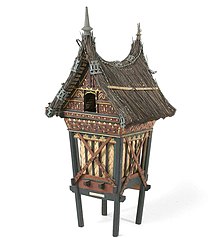
Rumah Gadang or Rumah Bagonjong "house for the Minangkabau people" are the traditional homes of the Minangkabau in West Sumatra, Indonesia. The architecture, construction, internal and external decoration, and the functions of the house reflect the culture and values of the Minangkabau. A Rumah Gadang serves as a residence, a hall for family meetings, and for ceremonial activities. In the matrilineal Minangkabau society, the Rumah Gadang is owned by the women of the family who live there; ownership is passed from mother to daughter.

Satu Suro is the first day of the Javanese calendar year in the month of Suro, corresponding with the first Islamic month of Muharram. It is mainly celebrated in Java, Indonesia, and by Javanese people living elsewhere.

Pagaruyung Palace is the istana of the former Pagaruyung Kingdom, located in Tanjung Emas subdistrict near Batusangkar town, Tanah Datar Regency, West Sumatra, Indonesia. It was built in the traditional Minangkabau Rumah Gadang vernacular architectural style but had several atypical elements including a three-story structure and a larger dimension in comparison to common rumah gadang.
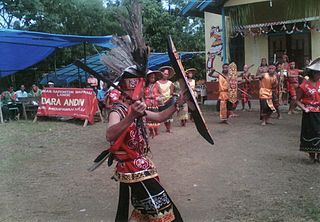
The Kendayan are an Indonesian ethnic group native to Kalimantan, Indonesia in Borneo. The population of the group is around 366,000.

Rumah adat are traditional houses built in any of the vernacular architecture styles of Indonesia, collectively belonging to the Austronesian architecture. The traditional houses and settlements of the several hundreds ethnic groups of Indonesia are extremely varied and all have their own specific history. It is the Indonesian variants of the whole Austronesian architecture found all over places where Austronesian people inhabited from the Pacific to Madagascar each having their own history, culture and style.

Gorontalo people, also known as Gorontalese are a native ethnic group and the most populous ethnicity in the northern part of Sulawesi. The Gorontalo people have traditionally been concentrated in the provinces of Gorontalo, North Sulawesi, and the northern part of Central Sulawesi.

Soerabaia 45 is an Indonesian film released in 1990. The film was directed by Imam Tantowi and starred Nyoman Swadayani, Leo Kristi, and Usman Effendy. The story of the film is based on the 1945 Battle of Surabaya between pro-independence Indonesian soldiers and militia against British and British Indian troops as a part of the Indonesian National Revolution.

Dr. Abubakar Jaar was a civil servant and lawyer for the Dutch East Indies. After the independence of Indonesia, he was mayor of Padang and resident of North Sumatra replacing Luat Siregar and resident of West Sumatra.
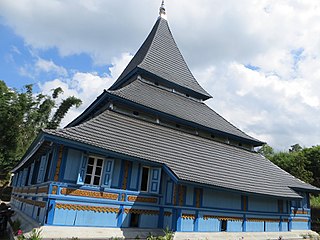
The Bingkudu Mosque is one of the oldest mosques in Indonesia, which was founded by the Padri in the wake of the Padri War in West Sumatra in 1823. This mosque with the typical Minangkabau style architecture is located in Jorong Bingkudu, Nagari Canduang Koto Laweh, Canduang District, Agam Regency, West Sumatra. When it was first built, the building of the mosque was made of wood, on its floor, pole, and its wall.
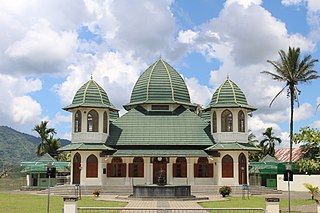
Nurul Iman Mosque of Koto Gadang or Tapi Koto Gadang Mosque is one of the oldest mosques in Indonesia, located in Koto Gadang Nagari, Agam Regency, West Sumatra. This mosque is the largest mosque in Koto Gadang area.
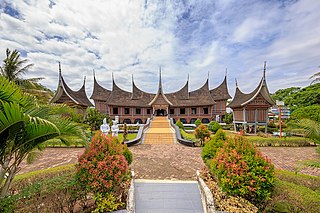
Adityawarman Museum is a State Museum located in Padang, Western Sumatra. As a State Museum, Adityawarman Museum is officially known as the State Museum of West Sumatra. The museum displays ethnographic collections of items related to the culture of the Province of West Sumatra, particularly the culture of Minangkabau and Mentawai.

A balairung is a village hall of the Minangkabau people of West Sumatra, Indonesia. It has a similar architectural form to the rumah gadang, the domestic architecture of the Minangkabau people. Whereas a rumah gadang is a proper building, the balairung is a pavilion-like structure used solely for holding a consensus decision-making process in the Minang society.
Huriah Adam was a famous dance artist from West Sumatra.
A Pujungan Inscription, also called Bronze Tongtong Inscription, is a short inscription written on a copper slit drum, which was found in the village of Pujungan in Pupuan District, Tabanan Regency, Bali, Indonesia. This inscription is thought to have been written during the reign of King Anak Wungsu in the 11th century. This is the first inscription that mentions the name Sasak, the name of the indigenous people of Lombok island.

Bedil tombak or bedil tumbak is a type of early firearm from the Indonesian archipelago. The weapon consists of a gun or small cannon mounted on a wooden pole, forming a type of weapon known as "pole gun".

Minangkabau culture is the culture of the Minangkabau ethnic group in Indonesia, part of the Indonesian culture. This culture is one of the two major cultures in the Indonesian archipelago which is very prominent and influential.

Music of Minang is a traditional and living genre of Indonesian music that grows and develops in the Minangkabau culture area. Music whose origins are related to Malay Music is generally played by musical instruments such as Talempong, Saluang, Minang rebab, Serunai, Tmbourine, Aguang, Gandang, and Violin. Minang music is also played to accompany various dances such as the Pasambahan dance and the Piring dance.

Roosseno Soerjohadikoesoemo was an Indonesian politician, scholar, and engineer. He served as minister of Public Works, Transportation and Economic Affairs during the first cabinet of Prime Minister Ali Sastroamidjojo. Roosseno planned several of the most notable buildings in Jakarta, including the Hotel Indonesia, Istiqlal Mosque, and the National Monument. His extensive use of concrete as a building material led thim being dubbed Indonesia's Father of Concrete".

Marawa is a tricolour flag that consists of three vertical charts that feature the colours of the Minangkabau culture: black, red, and gold. It is not known for sure when this flag was first used, but it was officially adopted as the flag of the Pagaruyung Kingdom since its founding in 1347. This flag was also adopted by other kingdoms of the Minangkabau rantau such as the Inderapura Kingdom. A derivative of the flag is also currently used by Negeri Sembilan, a state in Malaysia with historical and cultural connections with the kingdom.
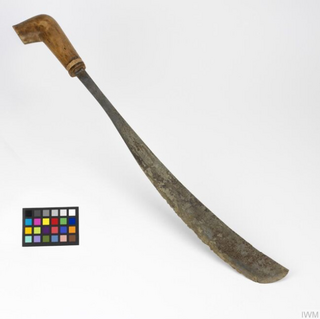
The Tangkin is a traditional parang (knife) of the Iban people from Sarawak, Malaysia and West Kalimantan, Indonesia.


